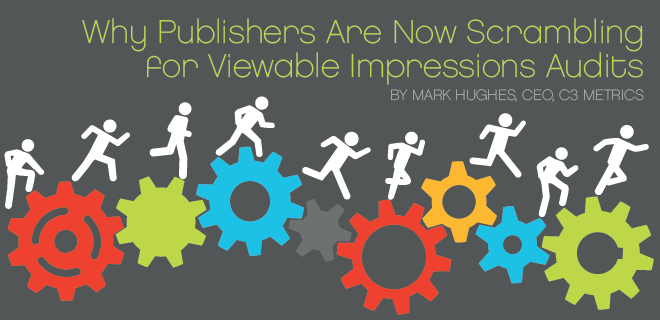
Most CFOs and CEOs don’t like surprises. Wall Street doesn’t either.
If you’re an online publisher, what’s likely got you scrambling now is the IAB/4A’s/ANA timeline for viewable impressions: starting Q1, parallel reporting begins. Not only will publishers be expected to report served impressions the same way as the past decade—publishers will be expected to report in parallel for viewable impressions: ads that appear in the viewport of the consumer’s screen for at least one second (though the tentative one second guideline could change).
Wall Street analysts are starting to hear about this and starting to ask what the impact of viewable impressions will be. In this parallel reporting period of both served display impressions and viewable impressions, not much will change except that advertisers will want to see both reports.
But very soon, advertisers, DSPs, and exchange stakeholders will be asking publishers for viewability data and securing it themselves if not readily available. This includes the very largest publishers (Facebook, Yahoo, Google, AOL, Turner, CBS, Fox, Viacom) and the very smallest of publishers.
To Wall Street analysts, one of the surprises will be discovering that most online insertion orders are governed by the IAB Standard Terms & Conditions. The impact? With a few keystrokes, a paragraph will be added, creating new definition around viewable impressions. And thus the governing Terms & Conditions for display advertising changes as quickly as a new PDF is uploaded. An over-simplification, yes, but practically speaking when that PDF is changed, everything changes.
With Q1 2013 approaching fast for the new parallel reporting, viewable impressions audits have become the industry’s new Y2K. Publishers need to be prepared and able to answer questions flying at them from all directions.
CFOs will want to know, “How will our bottom line be affected by the new standard; how many times is that ad served; how many times is it viewable; how much revenue is at stake; what’s our redesign plan, and will it be complete by 2013?”
Ad ops leaders will want to know, “Who’s doing viewable impressions; are they doing viewable impressions with iFrames; if we’re serving large ad formats (‘portrait’ or ‘devil’) will viewability guidelines actually penalize us since 50% of a large ad unit is harder to get in view than getting 50% of a small ad in view; and how will 7-inch tablets affect us?”
Although these things may not yet be certain, one thing’s for sure: the words “internal audit” for publishers aren’t nearly as scary as the surprise of not knowing.
So before Q1 2013 is upon us, publishers should be taking it upon themselves to proactively seek the answers to these questions and ensure they’re fully up to speed on viewable impressions. In addition to simply getting a jump on the industry, when a publisher is able to say, “we’re in the 90+ percentile for viewable impressions rankings over the last seven months,” that very fact will attract more revenue; or if low in the rankings, it may decrease revenue.
To some extent, it’s our modern-day Y2K, and we need to prepare accordingly. Déjà vu all over again.
Mark Hughes is CEO of C3 Metrics